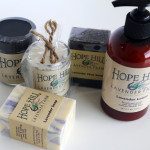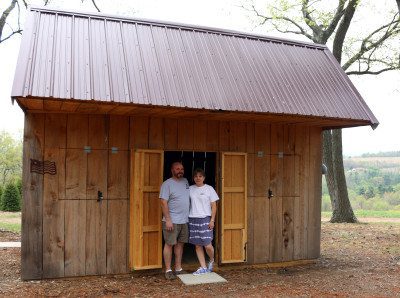Located in the mountains of Schuylkill County, PA, Hope Hill Lavender Farm has been home to Troy and Wendy Jochems for over a decade. Together they grow 6 different cultivars of lavender on their farm, using both organic soil and fertilization methods to help a total of 2500 plants thrive.
“We use Fertrell organic fertilizer and Organic Mechanics soil. The organic fish emulsion fertilizer we use helps the root system and brings the green out of our plants. Lavender has no pests that bother with it – our soil is very shale and deer and other critters don’t like the smell or taste of it. The only real problem would be root rot.” – Wendy
During our visit to the farm, we learned that each cultivar is grown for a unique purpose. Troy explains that Folgate and Hidcote, are “English lavenders ideal for culinary use because of they’re softer and sweeter smell,” while ultra fragrant Provence lavender is dried for use in sachets, and Grosso is distilled to produce essential oil. Cathy Blanc is “a white flower used for fresh cuts,” and the Jochems are experimenting with different uses for Grappenhall lavender on the farm. Through careful research, their involvement in the Lavender Growers Association, a national community and support system of growers, and hands on experience, the pair has learned the best growing tactics and uses for each type of lavender. They recently started beekeeping as part of a plan to create a sustainable ecosystem on the farm. Wendy explains that the bees benefit from the lavender, without taking away from the crop, “lavender doesn’t need to be pollinated to flower, but it’s a food source for the bees.”
Summer marks the beginning of harvest season at Hope Hill Farm. With the help of a neighbor or two, the Jochems gather the lavender by hand before securing it in bundles and hanging it in their drying shed, which was specially designed and built by Troy.
“We start cutting the Hidcote and Grosso for culinary lavender, the dried bouquets and the sachets. Then, when the lavender is a little more in bloom, you begin cutting for the oil and the distilling. Next, you go into the phase of propagating the plant. The plant tells us when to do all of that.” – Troy
Essential oil production also happens on the farm. Wendy explains that “harvesting the lavender for oil must be done at the peak of the day’s heat.” Pure essential oil is then “extracted by steam distillation from the fresh flowering tops,” before it is added to a variety of natural bath and body products. Propagating the lavender is a preparative step for the following year’s harvest. Wendy especially enjoys the process of, “taking something from a cutting and seeing it grow into a full size plant.”
 Each year, the Jochems family celebrates the harvest by inviting the community to visit the farm for a lavender festival. The field turns a beautiful shade of purple as the rows of lavender come into bloom – Wendy notes that one of her favorite things about growing lavender is “The look on peoples faces when they visit the farm.”
Each year, the Jochems family celebrates the harvest by inviting the community to visit the farm for a lavender festival. The field turns a beautiful shade of purple as the rows of lavender come into bloom – Wendy notes that one of her favorite things about growing lavender is “The look on peoples faces when they visit the farm.”
You can find Hope Hill’s culinary lavender in our Gourmet section, as well as lavender hand soap, lotions, candles, lip balm, room & body spray, and bar soaps in our Apothecary.







My would to know if u sell lavender and how much does it cost per pound. Thanx
Hello Brian, Thank you for reaching out! We sell lavender in our bulk section for $55/lb. (It is VERY light!) It is available at all locations except Douglassville and Ottsville. -Emily at KWF